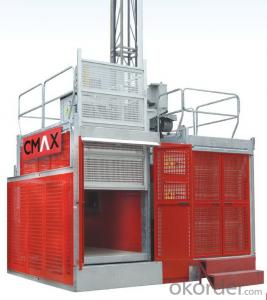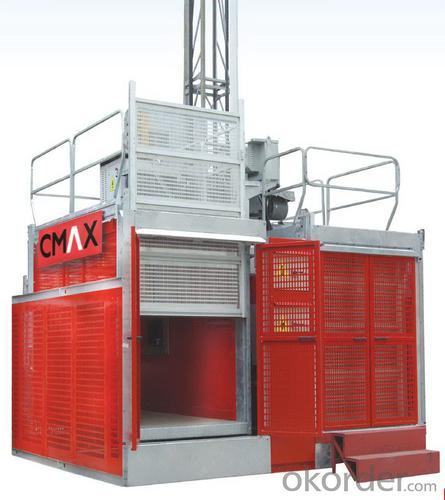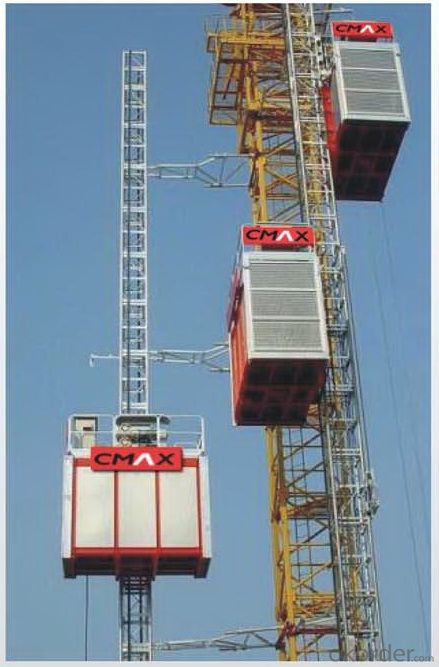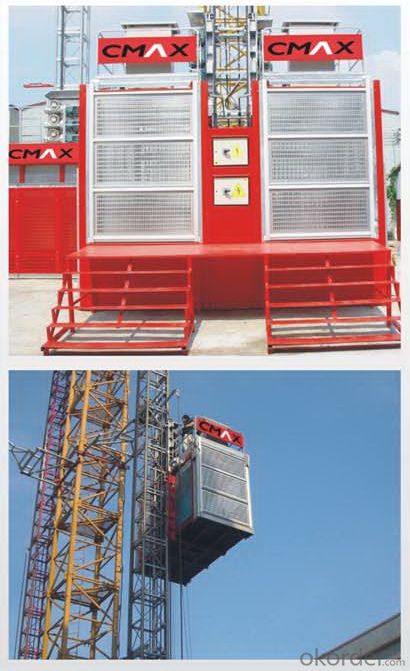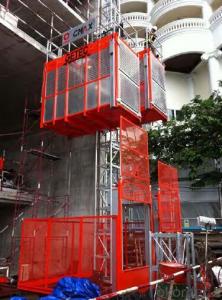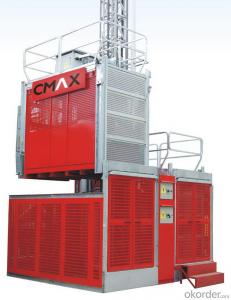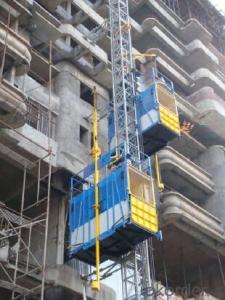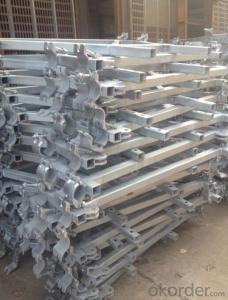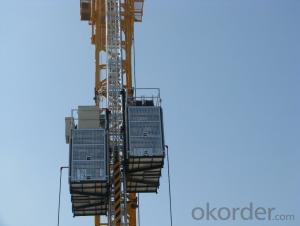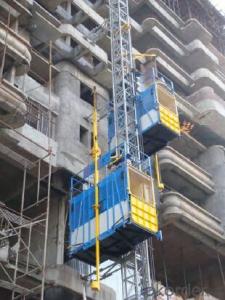Construction Hoist SC650 Series /Material Hoist /Building Hoist /Industrial Hoist /Lift /Elevator
- Loading Port:
- China main port
- Payment Terms:
- TT OR LC
- Min Order Qty:
- 1 set
- Supply Capability:
- 20 set/month
OKorder Service Pledge
OKorder Financial Service
You Might Also Like
Introduction:
CNBM designed and manufactured a brand new model construction hoist SC650 by absorbing advanced technology of the world, together with CNBM's unique and latest designing conception. The mast type of SC650 is 650x650mm and the rated load is 2000~3200kg, it is a kind of middle heavy duty hoist. SC650 adopts modular design, frequency control and strong mechanic strength steel, with compact structure, comfortable riding, high efficiency, convenient transportation and evergy saving. It is the best choice for vertical transportation of people and materials on almost all construction sites.
Features:
1. Modular design, easy to make different combinations according to specific requirement.
2. Can produce cage with length from 3.2m to 4.6m.
3. Adopting strong mechanic strength steel which makes light structure and large load capacity.
4. With many different models of cage door available. Aluminum structure, light weight and easy to open.
5. Both single cage and double cage are available. Fast and easy conversion between left and right cage.
6. Compact structure, convenient for transportation - can be directly packed into container.
7. Using gear to drive and brake, efficient and evergy saving.
8. Main components are hot dip galvanized which guarantee longer operational life.
9. Cable basket or cable guiding device with aluminum rail according to the requirement.
10. With frequency control and direct start available.
11. Advanced load inspection device, ensuring driving safety.
12. Meet European standard EN12159 and China standard GB/T10054.
Specifications:
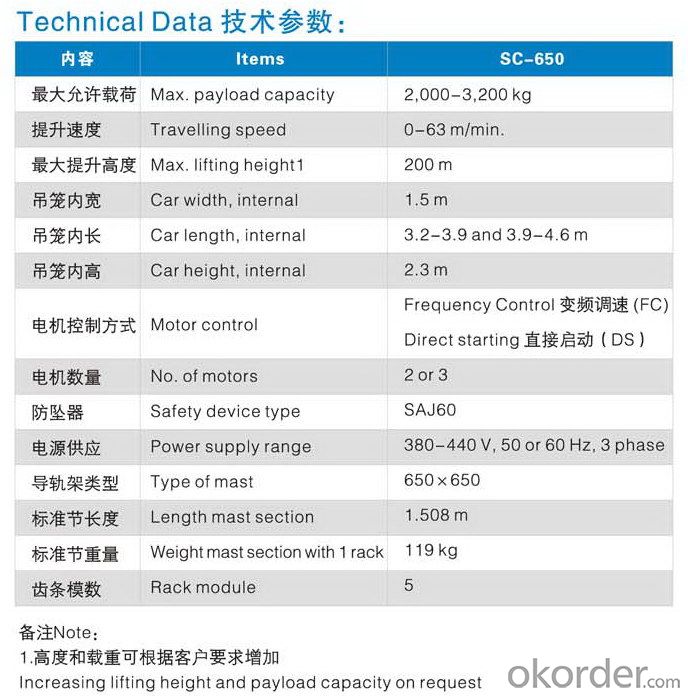
- Q: How does the construction lift fall without electricity
- Pull the manual release (or pedal release) to loosen the electric motor to loosen the brake, the lift will fall, and the speed localizer will die. It's not that professionals don't try "very dangerous"
- Q: This question asks if a building hoist is capable of lifting heavy objects.
- <p>Yes, a building hoist is specifically designed to lift large objects. It is a type of crane used in construction to move heavy materials and equipment to different levels of a building under construction. Building hoists can handle a significant weight, but the exact capacity depends on the specific model and its design specifications. They are essential for efficient construction processes, ensuring the safe and effective transportation of materials within the construction site.</p>
- Q: Is it possible to fix a building hoist or substitute it with alternative lifting machinery?
- <p>Yes, a building hoist can be repaired if the damage is not severe. If repair is not feasible or cost-effective, it can be replaced by other types of lifting equipment. There are various alternatives available, such as cranes, forklifts, and material hoists, each with its own advantages and suitable for different scenarios. The choice depends on factors like the weight of the load, the height of the building, and the specific requirements of the construction project. It's essential to consider safety, efficiency, and compatibility with the existing infrastructure when making such decisions.</p>
- Q: This question asks if a building hoist can be utilized for the purpose of lifting heavy objects.
- <p>Yes, a building hoist is specifically designed for lifting heavy objects in construction settings. It is a mechanical device that can lift and lower materials such as concrete, bricks, and tools to various levels of a building under construction. Building hoists are engineered to handle substantial weight and are equipped with safety features to ensure secure and efficient operation. However, it is crucial to adhere to the hoist's weight capacity and safety guidelines to prevent accidents and ensure the proper use of the equipment.</p>
- Q: The difference between the derrick and the construction elevator?
- You want the picture to still want to explain, the words to go to baidu search all can. The derrick is not to be multiplied by the person, the setting height is not more than 30 meters, now most of the place begin to phase out the use of the derrick, because the safety coefficient is low. The construction elevator can carry cargo, set up a height of 150 meters, and can carry a weight of 1-3 tons
- Q: How long does the construction elevator do a crash test
- You don't have to do it now. Go straight to the test center. A site is tested once
- Q: This question asks for the proper steps to install a building hoist, a device used in construction to lift materials and workers.
- <p>To install a building hoist correctly, follow these steps: 1) Ensure the site is suitable and inspect the hoist for any damages. 2) Assemble the hoist tower on a solid, level base. 3) Install the mast and guide rails according to the manufacturer's instructions. 4) Attach the hoist mechanism and cab, ensuring all connections are secure. 5) Conduct a thorough inspection and test the hoist's functionality. 6) Obtain necessary permits and inspections from local authorities. 7) Train operators on the safe use of the hoist. Always adhere to safety guidelines and manufacturer's specifications.</p>
- Q: This question asks if a building hoist can be set up either inside or outside a building.
- <p>Yes, a building hoist can be installed both indoors and outdoors. The choice between indoor and outdoor installation depends on the specific requirements of the construction project, the available space, and the building's design. Outdoor hoists are often used for high-rise construction, while indoor hoists are more common in multi-story buildings or where external space is limited. Both types require careful planning and adherence to safety regulations to ensure the safe and efficient movement of materials and personnel.</p>
- Q: When building tall buildings, the machine that USES to lift concrete to wait for tall building
- It should be the ground pump, the center is the tower crane, the construction face is the concrete pump of the cloth machine to the construction method. The advanced cloth machine is the arm bracket of the pump car, can operate with the remote control, is as convenient as the pump car.
- Q: This question asks for the steps or methods to keep a building hoist in good condition and fix any damages.
- <p>To maintain and repair a damaged building hoist, follow these steps: Regularly inspect the hoist for wear and tear, checking cables, pulleys, and brackets. Lubricate moving parts to reduce friction and prevent rust. Replace damaged or worn-out components promptly. Ensure all safety features are functioning correctly. If a hoist is severely damaged, consult with a professional to assess the damage and perform necessary repairs. Always adhere to the manufacturer's guidelines and safety regulations during maintenance and repair processes.</p>
Send your message to us
Construction Hoist SC650 Series /Material Hoist /Building Hoist /Industrial Hoist /Lift /Elevator
- Loading Port:
- China main port
- Payment Terms:
- TT OR LC
- Min Order Qty:
- 1 set
- Supply Capability:
- 20 set/month
OKorder Service Pledge
OKorder Financial Service
Similar products
Hot products
Hot Searches
Related keywords
